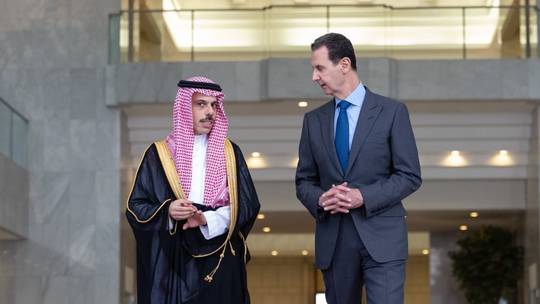As US Grip on Middle East Slips, Peace Breaks Out
CONFLICT RESOLUTION - MEDIATION, 8 May 2023
Robert Inlakesh | RT - TRANSCEND Media Service
Washington’s poor decision-making is starting to catch up with it, as nations choose to pursue peace without US interference.

Faisal bin Farhan Al Saud, Minister of Foreign Affairs of Saudi Arabia meets Bashar al-Assad on April 18, 2023 in Damascus, Syria.
© Photo by Saudi Arabian Foreign Ministry/Handout/Anadolu Agency via Getty Images
2 May 2023 – As Washington’s influence in the Middle East declines, countries throughout the region are taking to compromise, rapprochement, and peace talks, inflicting a blow to the US narrative that seeks to depict its role as a stabilizer and democracy advocate.
Under the leadership of US President Joe Biden, there has been a notable downgrade in the status of the West amongst various long-time Middle East allies. As the US-led West exerts the majority of its efforts on the war in Ukraine, its poor decision making in the Middle East has finally begun to catch up to it.
The first major blow to Washington’s influence came in the form of a Chinese-mediated agreement to end a decades-long feud between major regional actors Iran and Saudi Arabia, one which led to the severing of ties in 2016. This has a number of implications for US power in the region.
The first being that this collapsed a strategy that the US was developing, to unite Saudi Arabia with the likes of Egypt, the UAE, Jordan, Bahrain, and Israel, against Iran and its allies in the region; the alliance was speculated to serve as a “Middle East NATO.” The second is that the Iran-Saudi rapprochement appears to have caused Riyadh to scrap its plans for normalizing ties with Israel at this time, something that the Biden administration clearly values as a foreign policy achievement. There is also the additional aspect of this being negotiated by Beijing without any regard for how it would reflect on the White House.
Despite attempts in Washington to make the deal seem like something it approves of, and repeated remarks by Israeli Prime Minister Benjamin Netanyahu about how close normalization with Saudi Arabia is, it was clearly a blow and has major consequences to the US approach to the region. In March, Saudi Crown Prince Mohammed Bin Salman said that he didn’t care if the US President had misunderstood things about him, and later in April it was reported he also told advisors that pleasing the Americans is no longer a priority.
Immediately after the Saudi-Iran normalization, Riyadh entered into serious negotiations with Yemen’s Ansarallah (the Houthis), in order to end the war that has been raging between the two sides since 2015 and has claimed around 400,000 lives in the country. To make things worse for the US, Saudi Arabia’s foreign minister recently made a trip to Damascus to meet with Syrian President Bashar al-Assad. In addition to Riyadh’s moves and Tunisia re-establishing ties with Syria, it also appears as if Ankara may be on the cusp of rapprochement with Damascus and there is a push for Syria to be re-integrated into the Arab League, which clearly runs contrary to the US agenda.
Then we have the fact that Qatar has announced it is restoring ties with the United Arab Emirates and Bahrain, which is not as significant as the above mentioned moves, yet adds to a list of peacemaking decisions taken without America. On the level of optics, this makes it seem as if the common denominator is the absence of the US. On the other hand, Washington’s development of ties with the Kingdom of Morocco is egging on tensions with neighboring Algeria. Not only is the Biden administration adding fuel to the fire in the diplomatic feud between both sides, but is helping exacerbate military tensions in a Rabat-Algiers arms race. Earlier this April, the US approved a potential $524.2 million sale of HIMARS artillery rocket systems to Morocco.
Furthermore, the top Middle East partner of the United States, Israel, has been severely weakened by an ongoing domestic political crisis over a proposed judicial overhaul by the Israeli government. Problems have also arisen with Israel’s approach to issues like maintaining the status quo at the al-Aqsa Mosque in Jerusalem, a holy site where neighboring Jordan maintains custodianship, and it has caused major rows between Amman and Tel Aviv in recent months. This presents another obstacle to the US, which is being forced to mediate between both sides to maintain calm. Another layer is the feud between Biden and Netanyahu, which has called into question the special relationship between Israel and the US for the first time since the 1950s.
The US strategy in the Middle East has been to impose its dominance, primarily through the military sphere. Its selling points have been security, weapons sales, threats of military action against foes, and the creation of a Sunni-Shia cold war that pitted Iran and Saudi Arabia against one another. The strength of Iran’s weapons programs, along with its regional alliances, has largely left the US incapable of maintaining a military edge that severely outweighs the power of its opposition. The American overstretch in the region has seen it driven from Afghanistan in an embarrassing fashion and rendered it incapable of protecting its allies from the damage of potential missile strikes from Iran and its allies. Washington actively builds relationships based upon strategies that put its own partners in the firing line, but where air defense systems it sells to them do not provide enough protection.
Even when it comes to the Palestine-Israel conflict, an issue wedded to the US since 1967, US leadership is waning. Earlier this week, China’s foreign minister, Qin Gang, proposed to his Palestinian Authority and Israeli counterparts that Beijing step in to facilitate dialogue between the two sides. Although the conflict is not going to be solved overnight, the mere fact that another world power is stepping into the arena will certainly send a message to American policy makers.
Instead of engaging the region as equals, looking for economic partnerships that are mutually beneficial, the US has used its military might to divide and conquer, inflicting millions of deaths and spending trillions of dollars in the process. This may have succeeded in the past, but America’s ability to wage regime change wars has been severely curtailed. The main US enemies, Iran and its allies, have made significant leaps in the military field, making direct war increasingly unfeasible, and has even pressured Tehran’s former adversaries to rethink their strategies. Although we are only at the beginning of this new phase in the Middle East, it is clear that poor policy decisions and the inability of Washington to envisage a way forward are pushing away key allies, and this time for the better.
_______________________________________________
Robert Inlakesh is a political analyst, journalist and documentary filmmaker currently based in London, UK. He has reported from and lived in the Palestinian territories and currently works with Quds News. Director of ‘Steal of the Century: Trump’s Palestine-Israel Catastrophe’.
Tags: Anti-NATO, Anti-imperialism, BRICS, China, Conflict Mediation, Conflict Resolution, Conflict Transformation, Middle East, Peace, Saudi Arabia, Syria, USA
DISCLAIMER: The statements, views and opinions expressed in pieces republished here are solely those of the authors and do not necessarily represent those of TMS. In accordance with title 17 U.S.C. section 107, this material is distributed without profit to those who have expressed a prior interest in receiving the included information for research and educational purposes. TMS has no affiliation whatsoever with the originator of this article nor is TMS endorsed or sponsored by the originator. “GO TO ORIGINAL” links are provided as a convenience to our readers and allow for verification of authenticity. However, as originating pages are often updated by their originating host sites, the versions posted may not match the versions our readers view when clicking the “GO TO ORIGINAL” links. This site contains copyrighted material the use of which has not always been specifically authorized by the copyright owner. We are making such material available in our efforts to advance understanding of environmental, political, human rights, economic, democracy, scientific, and social justice issues, etc. We believe this constitutes a ‘fair use’ of any such copyrighted material as provided for in section 107 of the US Copyright Law. In accordance with Title 17 U.S.C. Section 107, the material on this site is distributed without profit to those who have expressed a prior interest in receiving the included information for research and educational purposes. For more information go to: http://www.law.cornell.edu/uscode/17/107.shtml. If you wish to use copyrighted material from this site for purposes of your own that go beyond ‘fair use’, you must obtain permission from the copyright owner.
Read more
Click here to go to the current weekly digest or pick another article:
CONFLICT RESOLUTION - MEDIATION:
